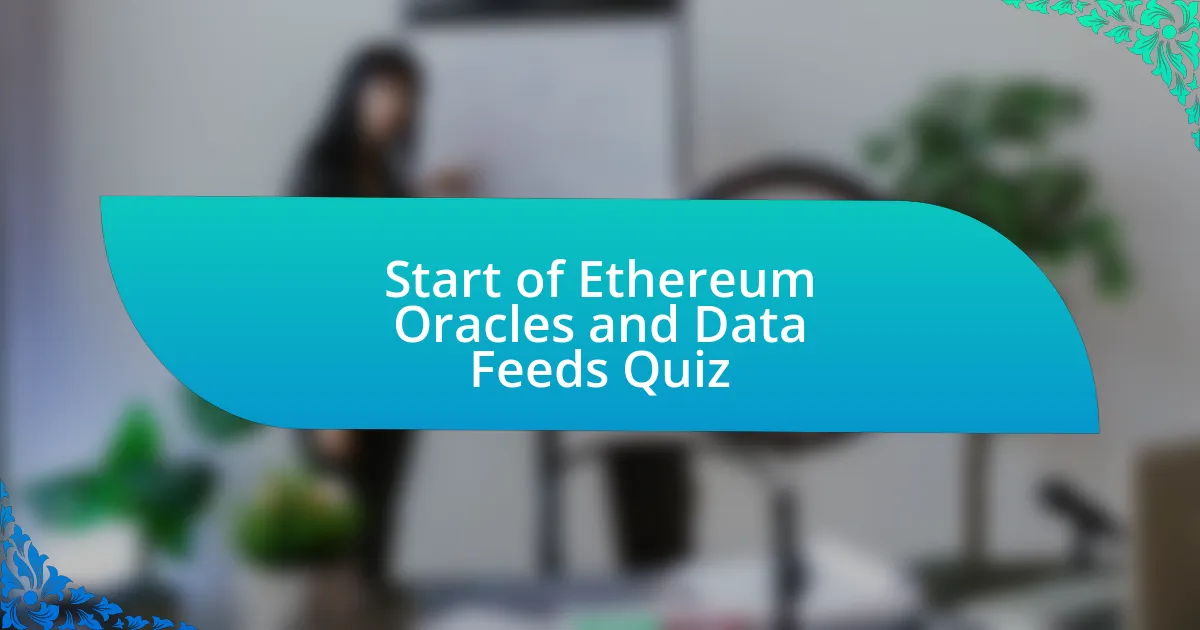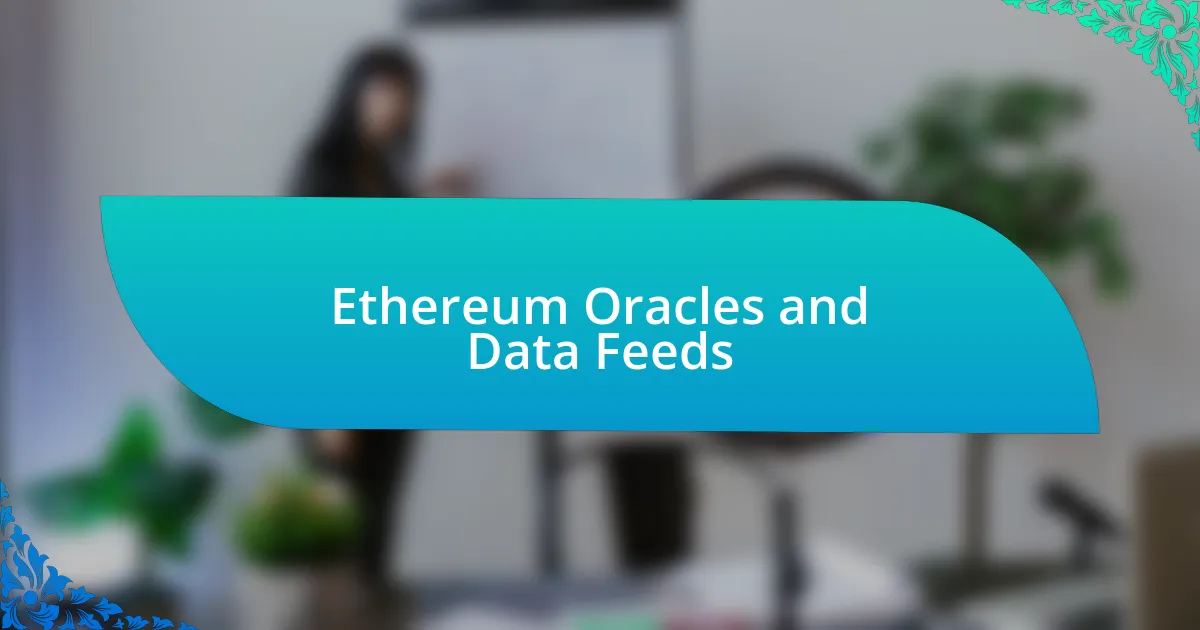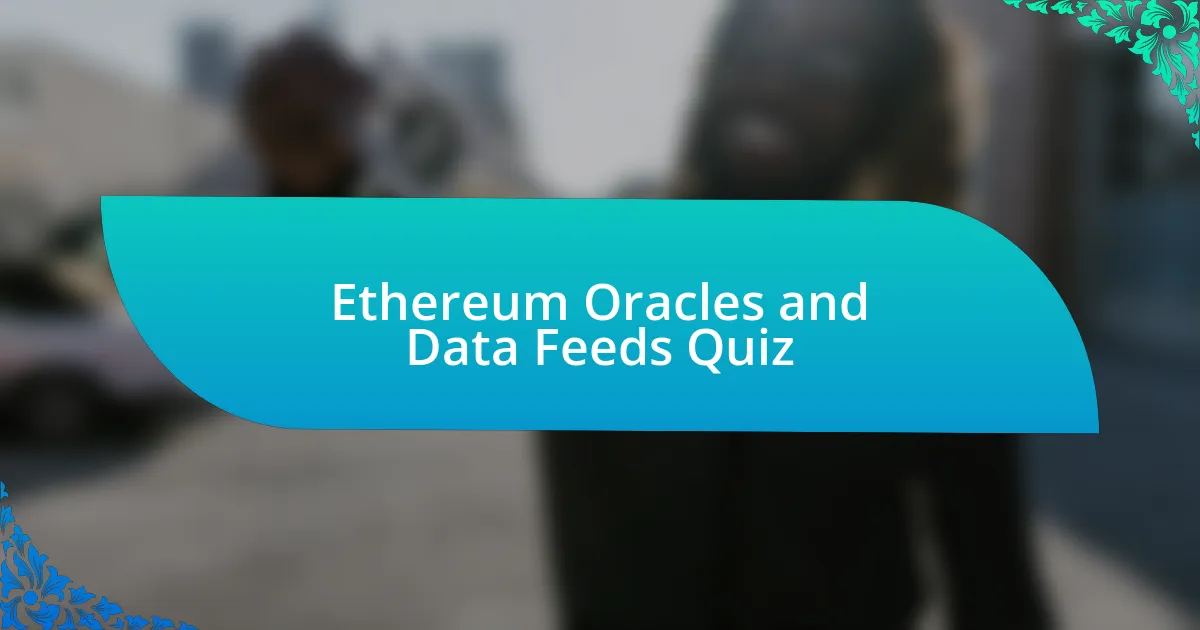
Start of Ethereum Oracles and Data Feeds Quiz
1. What type of data can Chainlink Data Feeds provide to smart contracts?
- Historical temperature records
- User login information
- Internet browsing statistics
- Real-world asset prices
2. How does a proxy improve the functionality of Chainlink Data Feeds?
- To limit access to certain user contracts only.
- To cache data locally for faster retrieval times.
- To allow the protocol to be upgradeable and point to the implementation – the aggregator.
- To collect all data from a single source for accuracy.
3. What differentiates immediate-read oracles from other oracle types?
- An oracle that processes complex queries from multiple sources.
- An oracle that stores historical data for future reference.
- An oracle that provides data only needed for an immediate decision.
- An oracle that aggregates data over a long period for analytics.
4. In Chainlink Data Feeds, what does the term `aggregator` refer to?
- The component that processes data and updates prices.
- The database that stores historical price information.
- The temporary storage for data fetched from the blockchain.
- The interface that allows users to interact with the smart contract.
5. What mechanism do Chainlink Data Feeds use to ensure robustness in data reporting?
- By relying solely on a single data source for accuracy.
- By requiring manual data entry from users.
- By using only historical data without real-time updates.
- By using multiple independent Chainlink node operators and implementing deviation threshold triggers.
6. How can consumers retrieve prices from Chainlink Data Feeds?
- By using a blockchain explorer for price queries.
- By posting a request on a public forum.
- By sending an email to the data provider.
- By calling the AggregatorV3Interface functions.
7. What happens when a deviation threshold is breached in Chainlink Data Feeds?
- All data sources are disconnected randomly.
- The feed stops sending data completely.
- The aggregator updates prices based on thresholds.
- The prices revert to the last known values.
8. Why is the roundId variable significant in Chainlink Data Feeds?
- To store the maximum price of each transaction.
- To record the number of node operators in the network.
- To verify the identity of data sources used.
- To keep track of each update, incrementing with each new price update.
9. What information can be queried through the AggregatorV3Interface?
- Prices and additional metadata
- User account balances
- Token supply information
- Only contract addresses
10. Describe the role of independent Chainlink node operators in data accuracy.
- By using a random sample of data from one source only.
- By depending solely on user feedback for accuracy.
- By using multiple independent Chainlink node operators and implementing deviation threshold triggers.
- By relying on a single centralized data provider for inputs.
11. What is a publish-subscribe model in oracle setup?
- A model for synchronous data retrieval only.
- A messaging pattern where subscribers receive updates without polling.
- A method for data storage on centralized servers.
- A direct connection between a client and a server.
12. How do oracles enable smart contracts to interact with off-chain data?
- By creating static data that never changes.
- By providing data from multiple independent sources.
- By restricting access to a single user.
- By storing data in a central database.
13. What is the significance of heartbeat thresholds in Chainlink Data Feeds?
- To handle all the reporting logic and update prices based on thresholds.
- To store historical prices in a decentralized manner.
- To monitor network traffic for Chainlink nodes.
- To validate transactions in the blockchain.
14. How does a request-response oracle function in the Ethereum ecosystem?
- An oracle that receives a query from a DApp, parses the query, checks payment and data access permissions, retrieves relevant data from an off-chain source, signs the transaction(s), and broadcasts them to the network.
- An oracle that solely stores data on-chain without any retrieval.
- An oracle that connects users directly to the blockchain without interfacing with DApps.
- An oracle that only provides historical data without any current query processing.
15. What kind of permissions might a request-response oracle check before fulfilling a query?
- Payment and data access permissions
- Transaction fee and network congestion permissions
- Contract expiration and renewal permissions
- User identity and location permissions
16. In what way does Chainlink secure its price aggregation process?
- By relying on a single centralized oracle for data verification.
- By allowing any participant to submit price data at any time without checks.
- By using multiple independent Chainlink node operators and implementing deviation threshold triggers.
- By using only historical price data without real-time updates.
17. How does the Chainlink system manage upgrades to its data feeds?
- By forcing all smart contracts to update manually.
- By running multiple upgrades simultaneously without coordination.
- By using a proxy that allows the protocol to be upgradeable.
- By completely replacing the existing nodes with new ones.
18. How can users leverage historical data provided by Chainlink Data Feeds?
- To store data permanently on the blockchain.
- To create real-time notifications for price changes.
- To limit access to current market data only.
- To query historical aggregators and historical data.
19. What does the term `AccessControlledOffchainAggregator` denote?
- To provide user authentication for smart contracts.
- To aggregate data from multiple sources only.
- To connect smart contracts directly to databases.
- To handle reporting logic and update prices based on thresholds.
20. How is the integrity of data maintained during the aggregation process in Chainlink?
- By ignoring discrepancies between data.
- By relying solely on user input for updates.
- By using a single centralized data source.
- By combining data from many independent Chainlink node operators.
21. Why might developers prefer using Chainlink for fetching real-world data?
- To provide a secure storage solution for files.
- To create a blockchain for private transactions.
- To replace traditional banking systems entirely.
- To connect smart contracts to real-world data such as asset prices.
22. How do price updates affect the operations of smart contracts using Chainlink Data Feeds?
- They result in the complete loss of data previously held by the smart contract.
- They trigger updates that inform the smart contract of new price data.
- They require manual input from the contract developers to modify prices.
- They automatically suspend contract operations during price fluctuations.
23. What is the primary benefit of having multiple data sources in Chainlink Data Feeds?
- To ensure higher data accuracy and reliability.
- To reduce the transaction fees for smart contracts.
- To limit the number of data points available to the network.
- To increase the speed of transaction processing.
24. Describe the request cycle of a request-response oracle.
- An oracle that receives a query from a DApp, parses the query, checks payment and data access permissions, retrieves relevant data from an off-chain source, signs the transaction(s), and broadcasts them to the network.
- A service that only stores data without responding to queries.
- An oracle that provides data asynchronously without a query.
- A type of blockchain that does not interact with smart contracts.
25. Can immediate-read oracles support complex data types, and if so, how?
- No, they are limited to string data types only.
- No, immediate-read oracles can only support basic data types.
- Yes, immediate-read oracles can support complex data types.
- Yes, but only if the data is in JSON format.
26. What role do signed messages play in the operation of oracles?
- To attest to the validity of the data at a given time.
- To permanently delete outdated information from the database.
- To encrypt all transactions to ensure secrecy.
- To generate new data points for future use.
27. What is a common application for immediate-read oracles within decentralized applications?
- To create complex algorithms for processing data.
- To provide data needed for instant decisions.
- To store data for future analysis.
- To aggregate data from multiple sources over time.
28. How does Chainlink handle situations where data from node operators significantly varies?
- By taking the average of all data points without filtering.
- By selecting the maximum value reported by node operators.
- By using a median approach to select the most accurate data.
- By ignoring the variations and using the latest data point.
29. What happens when a smart contract calls the latestRoundData() function?
- It retrieves the latest price data along with additional information.
- It transmits data off-chain for further processing.
- It resets all previous price data to begin anew.
- It updates the smart contract code to improve efficiency.
30. In what contexts are data feeds vital for the functionality of decentralized finance (DeFi)?
- To create digital tokens for marketing purposes.
- To connect smart contracts to real-world data such as asset prices.
- To make traditional finance regulations enforceable in DeFi.
- To secure smart contracts against malicious attacks.

Congratulations! You’ve Completed the Quiz
Well done on finishing the quiz about Ethereum Oracles and Data Feeds! You’ve engaged with key concepts that are pivotal in the blockchain ecosystem. Understanding how oracles work and their importance in bringing real-world data to smart contracts can truly expand your knowledge of decentralized applications. This quiz has likely shed light on how these data feeds operate and their role in enhancing the functionality of blockchain technology.
It’s wonderful to explore the intricacies of how oracles can solve the data problem for Ethereum. You might have discovered various types of oracles, their use cases, and the challenges they face. Each question you tackled has deepened your grasp of how these systems support transactions and decision-making on the network. This knowledge is fundamental for anyone looking to understand or work with Ethereum and its capabilities.
Now that you’ve completed the quiz, we invite you to delve deeper into the topic. Check out the next section on this page for more detailed information about Ethereum Oracles and Data Feeds. This resource will complement your quiz experience and help you build a more comprehensive understanding. Let’s continue this journey of discovery and expand your expertise even further!

Ethereum Oracles and Data Feeds
Understanding Ethereum Oracles
Ethereum oracles are decentralized systems that provide external data to smart contracts on the Ethereum blockchain. They bridge the gap between blockchain networks and real-world information. By fetching data from various sources, oracles enable smart contracts to react based on real-time conditions. This functionality enhances the versatility of decentralized applications (dApps), allowing them to perform complex operations beyond simple transactions.
The Role of Data Feeds in Ethereum Oracles
Data feeds are essential components of Ethereum oracles. They supply continuous streams of data required for smart contracts to execute properly. These feeds may include price data, weather conditions, or any off-chain information relevant to contract execution. Reliable data feeds ensure that smart contracts function accurately, maintaining trust and security within the ecosystem.
Types of Ethereum Oracles
There are primarily three types of Ethereum oracles: inbound, outbound, and hybrid. Inbound oracles transmit external data to the blockchain. Outbound oracles send data from the blockchain to external systems. Hybrid oracles combine both functionalities, catering to a wider range of use cases. Each type serves specific needs depending on the nature of the dApp and the data required.
Decentralized vs. Centralized Oracles
Oracles can be classified as either decentralized or centralized. Centralized oracles rely on a single source for data, which can introduce vulnerabilities. Decentralized oracles aggregate data from multiple sources, enhancing reliability and reducing the risk of manipulation. The use of decentralized oracles is crucial in preserving the integrity of the smart contracts that depend on them.
Examples of Ethereum Oracles and Their Use Cases
Chainlink is one of the most prominent Ethereum oracles, connecting smart contracts to various real-world data providers. Another example is Band Protocol, which focuses on aggregating data from multiple sources for better accuracy. Use cases for these oracles range from decentralized finance (DeFi) applications to supply chain management, showcasing their adaptability across various sectors.
What are Ethereum Oracles?
Ethereum Oracles are third-party services that provide external data to smart contracts on the Ethereum blockchain. They act as intermediaries, allowing smart contracts to interact with real-world data, such as asset prices or event outcomes. By bridging on-chain and off-chain information, oracles enable decentralized applications (dApps) to function properly in environments that require external information.
How do Ethereum Oracles work?
Ethereum Oracles work by fetching data from external sources and delivering it to the blockchain. They can operate in various ways, such as through centralized entities or decentralized networks. When a smart contract requires data, the oracle retrieves it, verifies its accuracy, and submits it to the blockchain. This process is essential for executing conditions defined in smart contracts, enhancing their capabilities beyond on-chain information.
Where are Ethereum Oracles utilized?
Ethereum Oracles are utilized in various sectors including finance, insurance, and supply chain management. They are crucial for decentralized finance (DeFi) applications, where real-time price feeds are necessary for trading and lending. Additionally, they are used in games and prediction markets to ensure fair outcomes based on real-world events. Their versatility makes them valuable across multiple industries that require reliable data input.
When were Ethereum Oracles introduced?
Ethereum Oracles were introduced alongside the development of smart contracts on the Ethereum blockchain, which launched in July 2015. The concept became more formalized with the emergence of specific oracle solutions, such as Chainlink in 2017. Since then, the use of oracles has expanded significantly, reflecting the growing demand for integrating real-world data into decentralized applications.
Who developed Ethereum Oracles?
No single entity developed Ethereum Oracles; rather, they emerged as a necessary component of the broader Ethereum ecosystem. Various projects and teams have contributed to their development, including Chainlink, Band Protocol, and others. These projects focus on providing reliable and secure oracle solutions to facilitate smart contract functionality by delivering trustworthy data from external environments.

